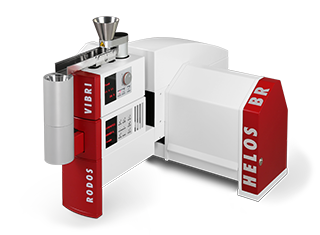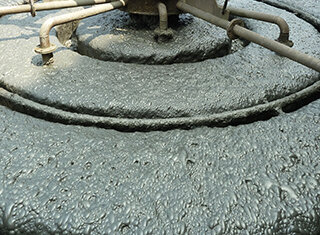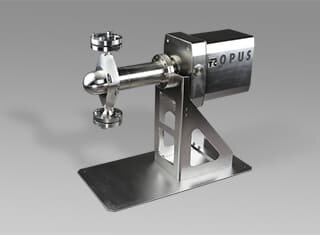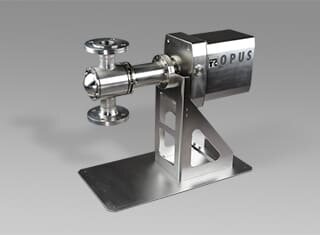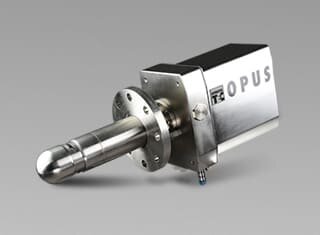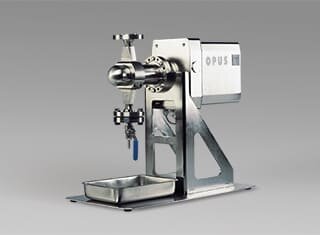Real-time particle size measurement of below 0.1 µm to 3,000 µm in highly concentrated suspensions and slurries in up to 4 production lines with ultrasonic extinction
The robust OPUS measuring probe makes a significant contribution to the process optimisation of wet milling and separation processes in the processing of ores and industrial minerals. As an acoustic measuring principle, ultrasonic extinction also delivers reliable and high-resolution particle size analyses in a range of below 0.1 µm to 3,000 µm in highly concentrated, optically non-transparent suspensions and slurries and simultaneously determines the particle concentration. In combination with the sample distribution system MULTIPLEXER, product flows containing sediment from up to four process lines can be transported to the OPUS sensor for characterisation. Sample feeding, measurement and evaluation can be remotely controlled and automated via the connection to a process control system. The measurement results obtained in real time are available to the control system for direct control or process monitoring.
The real-time monitoring of particle size in wet treatment methods places particular demands both on process coupling and sample handling and on the stability and reliability of the measurement technology used. The on-line measuring system, consisting of MULTIPLEXER for the process connection and the ultrasonic extinction sensor OPUS for particle characterisation of the slurries and suspensions, was developed specifically for these requirements. Up to four production lines can be automatically sampled according to a definable time pattern and measured using a single sensor.
MULTIPLEXER enables controlled sample feeding to the OPUS sensor from multiple connected process lines. In primary sampling, partial flows from the process line that are as representative as possible are continuously transported to the MULTIPLEXER at flow rate of approximately 2,000 l/h to 7000 l/h. The incoming sample flows initially flow past the sensor in basic operation (bypass) and are then guided into the sample outlet via a sump. MULTIPLEXER waits for an analysis request from the control system and then initiates a sample introduction. In a corresponding signal, a pneumatic actuator presses the respective hose line of the sample inlet into the position for filling a collecting tank which is connected upstream of the sensor. The predefined sample volume – typically from 200 l to 300 l – flows through the OPUS measuring gap and is analysed in a continuously operating measurement cycle of approximately 90 seconds. Once the analysis measurement is complete, the empty collection tank and the OPUS measuring zone are automatically cleaned with rinse water by various nozzles and are then available for the analysis of the next production line.
Abrasive suspensions with a high concentration of abrasive solid particles, as found in ore dressing or in the processing of industrial minerals, present particular challenges for handling the product flow and the materials coming into contact with products. The design of the sample distributor MULTIPLEXER is tailored to achieving long service lives at maximum sample throughput. Protective screening and the intentional prevention of closing fittings ensure the reliable and continuous management of the product flow. The flow control is designed to ensure flow speeds that are as low as possible within the MULTIPLEXER in order to minimise abrasions. This is achieved with short conveying distances between the sample supply, sensor and sample outlet and the interconnected collection, distribution and overflow tanks. Level sensors, flushing devices and the use of wear-resistant materials (sensor, protection screens, sump made of stainless steel, reinforced NBR hoses, tanks made of PVC) not only increase operational reliability and availability, they also simultaneously minimise maintenance.
Individual, customer-specific adaptation to the existing process environment and to the products that are to be measured takes place in close cooperation with the customer's process engineers and is accompanied by our experienced engineering team. As an option with a conventional, remote measurement computer, the system can also be equipped with an integrated Panel PC that allows local and autonomous operation.
- Particle size, particle size distribution and concentration
- For suspensions and slurries in original concentration
- Real-time analyses of up to 4 lines with automatic sampling | on-line
- Highly resolved measuring range from < 0.1 µm to 3,000 µm | 31 measuring points
- Monitoring of multiple process lines with one sensor | Multiplex installation
- Designed for long service lives even with abrasive product streams
- Automated cleaning with flushing nozzles | High availability
- Connection to process control systems | Modbus®, Profibus®, OPC, TCP/IP, SPS signals






